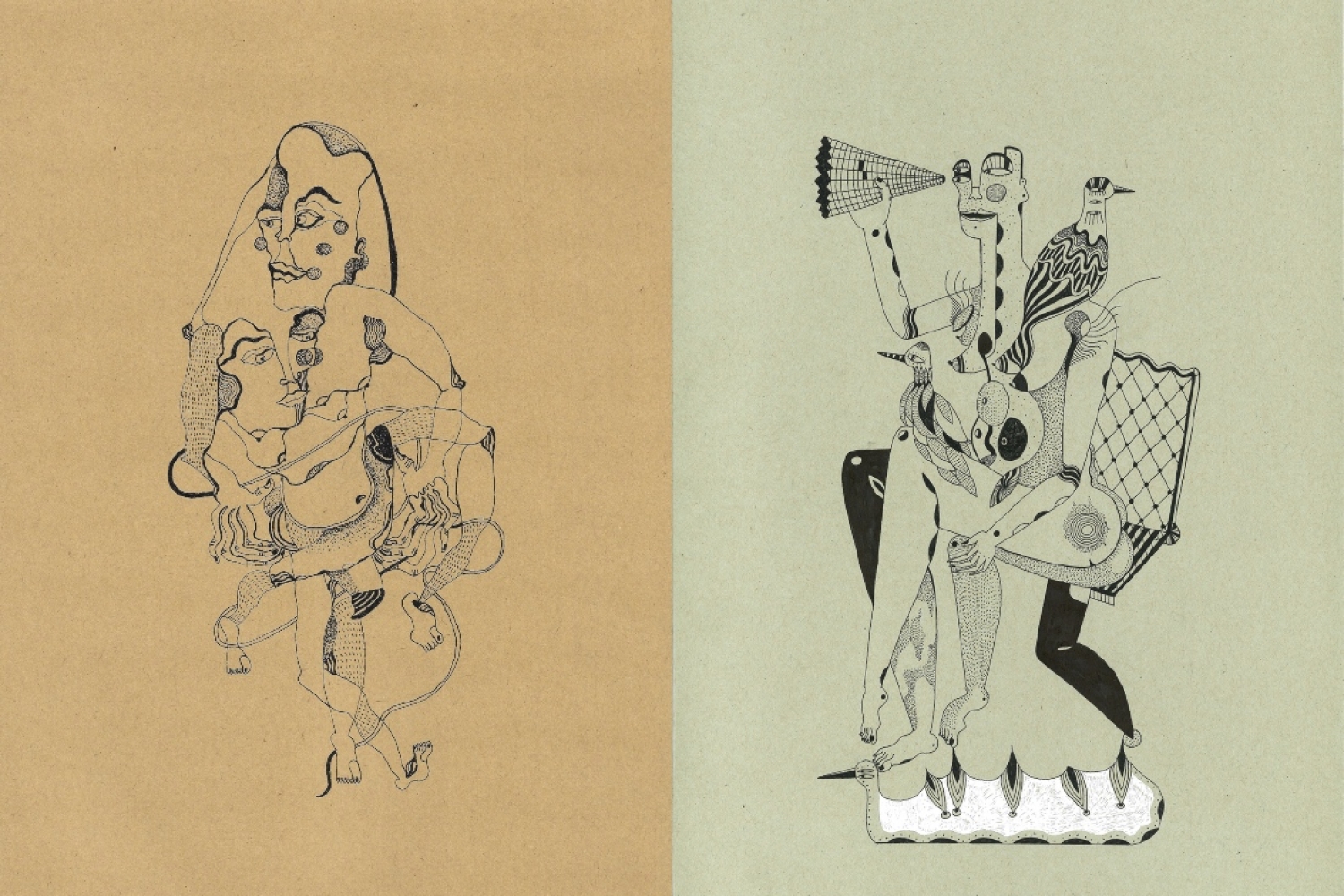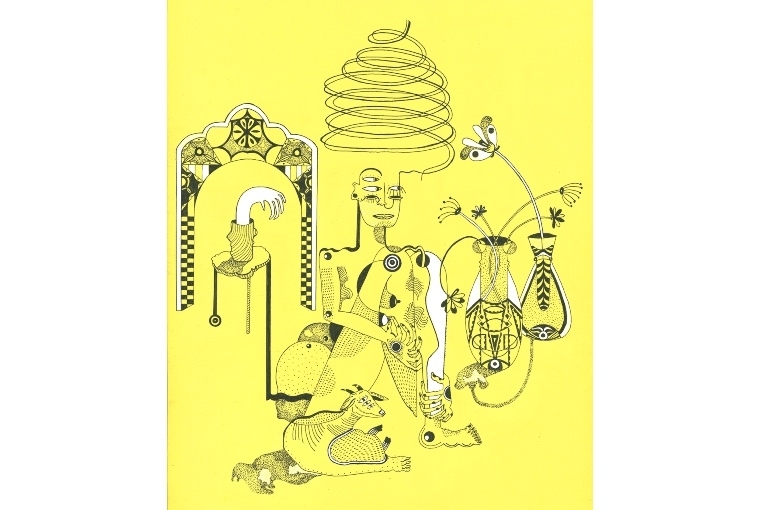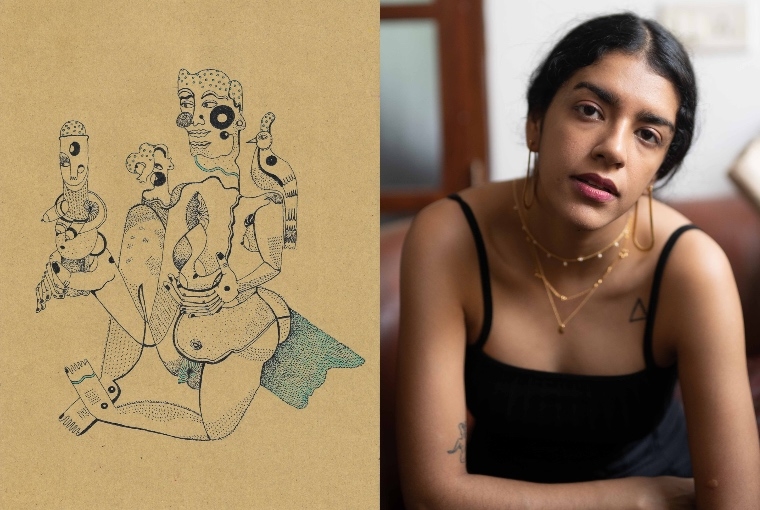
L: Dependency; R: Migration

L: Dependency; R: Migration
Fine artist, sculptor and curator Tarini Sethi, transcends the bounds of normal to create and curate works of art that redefine aesthetics. Her surrealist, even subversive, images spark curiosity and awe, for in the fine lines of her works lay layers of intricate expression. The idiosyncrasies of her talent and art is visible in the way she uses space, often melding together disparate motifs seamlessly. To make meaning of her illustrations is an experience in itself, for each viewing offers something new to behold. Having studied from Pratt Institute, New York, Tarini, along with Anant Ahuja, went on to curate India’s first ‘anti art fair’, The Irregulars Art Fair, giving a platform to rising artists. Now, she has launched The Irregular Times, an art and design newspaper which aims to be a publication for art moguls and laypeople alike. In a riveting conversation, we talk about art, life and more.
How did your interest in the world of art begin?
I think my answer to this is always going to be a bit cliched. Like most artists, I have been surrounded by art since I was a young lamb. I’ve found that to talk about myself as an artist, it's always important to talk about my family history and upbringing. My paternal grandfather studied in the J.J School of Art in Bombay. I never actually saw any of his work until a few months ago when we unearthed a large collection of intricate watercolour paintings. He then went on to start one of India’s first design studios post Independence, obviously completely analogue at the time. My dad took over the studio later on and is now a product designer, while my mother runs South Asia’s first encyclopaedia on traditional arts, crafts and textiles. So the creative gene really runs in the family. The house has always been covered with art from different parts of the world and being an artist has always been pushed and supported since day one, which is extremely important while being creative.
How would you describe your personal artistic and creative style?
I think both my personal and artistic style is a mix of experiments with surrealism, dada-ism and humour.

She was stuck in a rut
Can you deconstruct your creative process for us?
When I work, I usually never have a very strict idea in mind of what I’m going to create — things sort of flow out of my brain and start to make sense. When I do want to draw something specific, I still try to keep the theme a bit vague and do some research beforehand. I have tons and tons of books of paintings, prints, photographs, performance art, folk tales, architecture and more, just to get inspired. What I think is most important is to stretch my mind, and do things I’m uncomfortable with. Like starting straight with a pen instead of making sketches. It makes you understand that making mistakes is ok, and working with them creates bizarre and great results. So my process is extremely experimental. There are a lot of times I hate what I do and start over, and that’s ok as well.
Why art? What impact do you think it has on people?
In my personal opinion, art is a language that everyone can speak and understand. It breaks barriers of class, gender, religion and that’s what I love most about it. It usually creates intense, extreme reactions of love and hate, gets people thinking and questioning.
Through your art, what stories do you wish to tell?
My work constantly revolves around the idea of ‘Utopias’ and a world where we can live free and equally, without judgement both from others and our self. I draw inspiration from folk tales, architecture of cities I know and live in, and stories of kings and queens alongside twists and turns of modern day politics. It’s important for my work to be as interactive and all consuming as possible. I just want people to stretch their imagination and feel like they've entered a new world. That’s the most important thing for me. I want them to feel something, even if it’s extreme hate towards the art, but it should incite some kind of emotion and I want them to leave knowing they have experienced some kind of alternate space.
Whether in the arena of art or in life, who, or what, are some of your greatest influences?
I’m in love with Dali’s work and really identify with his creative process. Miros’ balanced but intricate work really gets to me. I have a bunch of books on Japanese art that I inhale often, especially the art of ‘shunga’, which is Japanese exotic art usually represented in wood block prints. I also love Indian miniature paintings, company paintings, and study a lot about motifs, patterns, Indian games. The art of ‘play’ is something quite interesting — board games, physical games from around the world depicted in art. Honestly the list doesn’t really stop for me because I collect a lot and get inspired and influenced by so many different things.
What role, according to you, does the artist occupy in society?
For me, the artist is a storyteller, we have a voice and an opinion, and express all this on our canvas or medium of choice.
What has it been like to try and make a space for yourself, within the already defined boundaries of the domain of art in India?
It’s definitely been tough, but the Indian art market has really started to open up to new people and new ideas, and that was the most challenging part in the beginning. Of course the other challenging part is getting representation or showing at a gallery, but I’ve realised that you really just need to talk to everyone you meet, learn from them, ask them questions, and understand what you can do within the space and confines you’re in.
Let's talk about The Irregulars Art Fair. What was the ideation behind it, and how has it grown since?
So previous to TIRAF, I had been curating small shows, which started from the idea of just building more platforms and spaces for artists to showcase their work. As an artist who was also trying to break into the gallery scene, I knew how tough it was and how there were very limited spaces compared to the number of growing artists in our country. So, I told myself that I could just teach myself and start curating small shows. Two years later, TIRAF was born, which was the opposite of small — it was huge and crazy and something we never imagined would grow to the size it has. It just shows, that something like this was really needed in our country, and what’s so fantastic is the number of people who’ve started independent spaces like this since. It’s important to remember that these places exist for the community and to encourage more individuals to feel empowered to do similar things.
Why do you call it an ‘anti art fair’?
We’ve been asked this quite a bit, and many people have asked whether it means that we are anti The India Art fair. I actually love The India Art fair and hope to show with them one day, and so it doesn’t in any way mean that we are anti-art or anti art fair. An anti art fair is basically an alternative art fair, and exists around the world. Most anti art fairs specifically take place at the same time as their cities’ main art fairs, so that people visiting from outside those cities can visit both at the same time, while also getting two very different experiences.
You recently came out with the first edition of The Irregular Times. What makes it different from other art and design newspapers?
Well one, it’s both art and design in one newspaper as opposed to having them separate. Since the newspaper had so many different features, articles and interactive pieces, it’s imperative we have a design language that gives us enough leverage to experiment and break rules, but at the same time bind the whole publication together. We ended up experimenting with over 15 different typefaces. The way we approach the newspaper is very similar to how we approached the art fair. We wanted to experiment with new ideas, be as interactive as possible, and make sure that this platform was not just for the artist community but had a wider reach and was both accessible and understandable to a more diverse community of creatives.
When we started ideating on the newspaper, there were a few things that both of us were sure about. One being that we wanted to bring back the element of surprise that older publications used to have. Second, we wanted to make it as interactive as possible. Third, we wanted people to WANT to hold on to the newspaper, and go back to it whenever they were looking for inspiration, ideas, or just to learn something.

L: The Company We Keep
Who is your target audience for The Irregular Times?
It’s important to maintain that ​​our newspaper is for everyone and not just artists. Which is why there are so many interactive columns within the newspaper, to really get non-artists comfortable with experimenting and asking questions. For example, with the ‘DIY Zine’ section, we want people to be able to learn a new craft in every issue. It’s interactive and readers can really get their hands dirty in this section. We encourage them to cut the page out, fold it and really go crazy.
This is similar to our adult colouring page ‘Adults Anonymous’, where readers can colour into the lines. We wanted the artwork here to be as graphic and sexual as possible to get people used to the idea of ‘sex’ without having to really talk about it. Even our ‘Asking For A Friend’ section is for people to be able feel free to talk about their problems and understand that it's okay to ask for help. All in all, the newspaper really aims to be for everyone, and we’re slowly trying to push that with the kind of content we’re curating.
Lastly, what's next for you?
That’s a great question, but honestly all I'm trying to do at the moment is balance these two alter egos of curating and creating. As of now, I'm just working towards exhibiting and making more art, while also really focusing on building the newspaper.
Text Devyani Verma
Date 09-08-2021